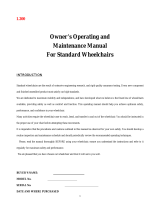
Tracer® EXI 18 Part No. 1110547
SECTION 2 SAFETY INSPECTION
SAFETY INSPECTION CHECKLIST
NOTE: Every six (6) months or as necessary, take your wheelchair to a qualified technician for a thorough
inspection and servicing. Regular cleaning will reveal loose or worn parts and enhance the smooth opera-
tion of your wheelchair. To operate properly and safely, your wheelchair must be cared for just like any
other vehicle. Routine maintenance will extend the life and efficiency of your wheelchair.
Section 2 - Safety Inspection includes the following:
Safety Inspection Checklist Troubleshooting Maintenance
SAFETY INSPECTION
Initial adjustments should be made to suit your personal body structure needs and preferences.
Thereafter follow these maintenance procedures:
ITEM Initially Weekly Monthly Periodically
GENERAL
Wheelchair rolls straight (no excessive drag or pull to one side). X X
Inspect for loose/missing/broken hardware in all locations. X X
FRAME AND CROSSBRACES
Inspect for bent frame or crossbraces. X X
WHEEL LOCKS
Do not interfere with tires when rolling. X X
Pivot points free of wear and looseness. X X
Wheel locks easy to engage. X X
Wheel locks prevent wheelchair from moving when engaged. X X
SEAT AND BACK
Inspect upholstery for rips or sagging. X X
Inspect for loose or broken hardware. X X
Inspect cane hand grips for wear/looseness/deterioration. X X
TIRES
Inspect for flat spots, cracks and wear. X X
If pneumatic tires check for proper inflation. X X
CAUTION: As with any vehicle, the wheels and
tires should be checked periodically for cracks and
wear, and should be replaced if damaged.
REAR WHEELS
No excessive side movement or binding when lifted and spun. X X
Inspect wheels for cracks and wear (hub and rim). X X
Inspect for cracked, bent or broken spokes. X X
HANDRIMS
Inspect for signs of rough edges or peeling. X X
FRONT CASTERS/FORKS
Inspect wheel/fork assembly for proper tension by
spinning caster; caster should come to a gradual stop. X X
Adjust bearing system if wheel wobbles noticeably or
binds to a stop. Ensure wheel bearings are clean and
free of moisture. X X
Check headtube locknuts for tightness. X X
Inspect casters for cracks and wear (hub and rim). X X
Inspect for cracked or broken spokes. X X
CAUTION: As with any vehicle, the wheels and
tires should be checked periodically for cracks and
wear, and should be replaced if damaged.
CLEANING
Clean upholstery and armrests. X X




















